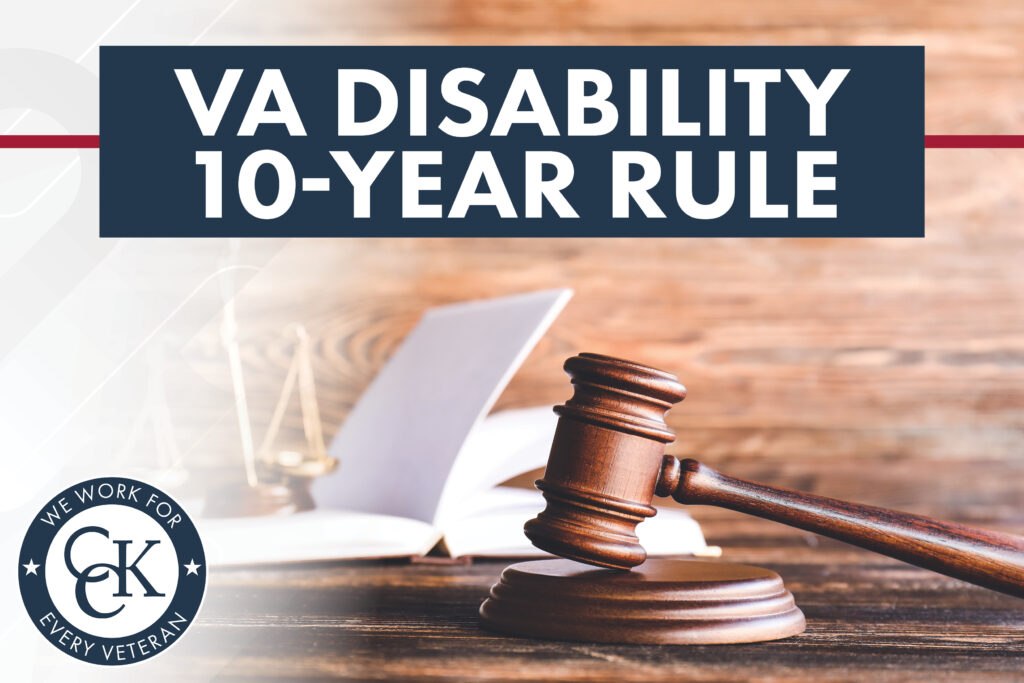VA Disability 10-Year Rule

CCK Law: Our Vital Role in Veterans Law
What Is the VA Disability 10-Year Rule?
The VA disability 10-year rule states that the U.S. Department of Veterans Affairs (VA) cannot eliminate a disability rating that has been in place for at least 10 years unless there is evidence of fraud. This 10-year period is calculated from the effective date of VA’s original grant for service connection.
However, VA can reduce a disability rating after 10 years if there is substantial medical evidence suggesting steady improvement of the veteran’s condition over time.
How Does the VA 10-Year Rule Help Veterans?
The VA 10-year rule exists to protect veterans from unfair termination of disability benefits. If a veteran maintains service connection for a condition for at least 10 years, their grant of service connection is considered protected. This means the service connection can no longer be terminated under the usual procedures, even if there is clear and unmistakable evidence.
Again, after 10 years of service connection, only evidence of fraud can potentially allow for the severance of disability benefits. Essentially, the 10-year rule allows veterans to receive some amount of VA compensation for their service-connected disability for the remainder of their life.
Can VA Reduce a Rating After 10 Years?
While VA cannot terminate service connection for a veteran’s condition after 10 years, it can still reduce the veteran’s disability rating.
In order for VA to reduce a disability rating under the 10-year rule, it cannot base the reduction on a single VA exam. VA must first propose the reduction based on a review of the veteran’s entire medical history. Any examination reports used as evidence must be based on thorough examinations.
Additionally, VA outlines the general criteria for reducing ratings in 38 CFR § 3.105(e), which states that a reduction may only take place if:
- There has been an actual change in the disability since the last rating decision; and
- The change reflects a material improvement in the veteran’s ability to function under the ordinary conditions and stressors of life and work.
A veteran’s disability rating for a specific condition is not fully protected until after the 20-year mark (i.e., the 20-year rule).

Other Protected VA Disability Ratings
In addition to the VA 10-year rule, there are several other circumstances where veterans’ ratings are protected, including:
100% VA Ratings
If VA assigns a 100 percent rating, it cannot be reduced unless material evidence shows a significant improvement in the veteran’s ability to function on a day-to-day basis.
VA Disability 5-Year Rule: Protected Ratings
According to the VA disability 5-year rule, a disability rating can only be reduced after five years if VA obtains medical evidence indicating the veteran’s condition is substantially improving over time on a sustained basis.
VA Disability 20-Year Rule: Continuous Ratings
Service-connected conditions rated at or above a certain disability rating for 20 years or more are considered continuous. According to the VA 20-year rule, VA cannot reduce a continuous rating below its original disability rating unless the rating was based on fraud.
Permanent and Total (P&T) Disability Ratings
VA grants Permanent and Total (P&T) disability to veterans whose service-connected conditions are considered total (rated 100 percent disabling) and permanent (zero or close to zero chance of improvement).
If VA determines a veteran’s condition is permanent and total, they are protected from reduction and will continue to receive disability compensation at a 100 percent rate for the remainder of their life.
Veterans Over Age 55
Veterans who are over the age of 55 are protected from VA rating reevaluations in many situations. This is a case-by-case determination.
Challenging a VA Rating Reduction or Termination of Benefits
If before the 10-year mark VA decides that severance of service connection is warranted based on a finding of clear and mistakable error, it must issue a notice of proposed severance. Similarly, if VA determines that before or after the 10 years a rating reduction may be warranted, it must issue a notice of a proposed reduction.
In both situations, the veteran then has 30 days to request a hearing and 60 days to submit new evidence.
If a veteran requests a hearing, VA cannot issue a new rating decision until the hearing takes place. However, requesting a hearing is not necessary to challenge a VA proposed rating reduction – veterans can also simply submit new evidence within 60 days.
If, after this process, VA sends a final decision that reduces or severs the veteran’s disability rating, the veteran can appeal VA’s decision by requesting a Higher-Level Review, submitting a Supplemental Claim, or filing a Notice of Disagreement.
How CCK Can Help if VA Reduces Your Rating
Appealing a VA decision or a proposed rating reduction can be a challenging process. If VA reduced or revoked your rating despite your service-connected condition having no substantial improvement, Chisholm Chisholm & Kilpatrick LTD may be able to help you appeal the decision. The veterans’ advocates at CCK have decades of demonstrated success in representing veterans before VA and the Court of Appeals for Veterans Claims (CAVC).
Reach out to CCK today to schedule a free consultation.
About the Author
Share this Post